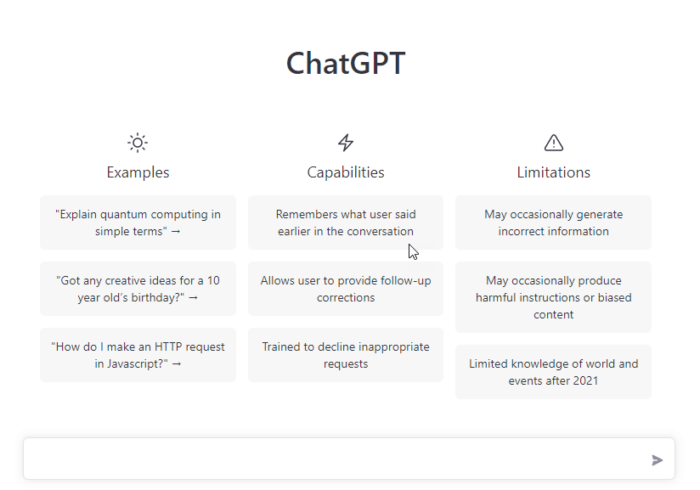January 30 2023
Breaking Down the Chatter Behind ChatGPT
The Latest AI Innovation
Artificial Intelligence powerhouse OpenAI released a free research preview of ChatGPT last November to gather user feedback. Over a million people tried it in the first week, and the new bot has been on heavy rotation in the news cycle ever since. It even wrote an article about itself. The reaction overall has been very black-and-white, with some early adopters and heated detractors.
While developments are still pending, the world of search could see changes in various applications and in various industries. In this blog, find out what ChatGPT can and cannot do, plus what shifts you should expect for the world of search.

How ChatGPT Works—A High-Level Overview
Computers are famously literal and don’t work well unless you use them in a certain way—this is how classic user errors are born. That’s what large language models like OpenAI’s GPT (Generative Pre-trained Transformer) technologies strive to fix and hope to offer flexible, friendlier interactions. One application of this you may have come across is a customer service chatbot.
The pandemic saw a rise in these chatbots overall, but it wasn’t a smooth takeover. Surveys from Verint and Ujet last year uncovered substantial customer dissatisfaction. These respondents were quick to list desired performance improvements including contextual and language understanding and the ability to recall past issues.

ChatGPT looks to tackle this problem. It was built atop the GPT family of large language models and refined with both supervised and reinforcement learning techniques. Users type in questions and the chatbot gives conversational answers using the bounty of information available via the internet. Plus, it can recall previous questions and answers to inform its next response. ChatGPT can generate programming code too.
It was first programmed to recognize patterns in the text it harvests, then human AI trainers provided conversations in which they played both the user and the chatbot. Training activities include receiving a paragraph with a few words deleted, then the AI filled in the blanks, and this was compared to the original—rewarding the AI system for coming as close as possible. The dialogue format allows ChatGPT to answer follow-up questions, admit its mistakes, challenge incorrect premises, and reject inappropriate requests. It’s a huge leap in chatbot technology.
ChatGPT is available for free during its feedback period and a paid version called ChatGPT Plus was recently announced for $20 a month. The Plus version gives users priority when the platform is at user capacity, which is often, and promises faster responses and first dibs on new features.

ChatGPT Isn’t Perfect
Google supplies users with suggested answers to queries via links to websites the algorithm deems trustworthy and relevant. ChatGPT’s answers will be more robust than Google’s definition features but won’t have source links or include videos and images. ChatGPT is a word organizer, an AI programmed in such a way that it can write coherent sentences but was never trained to identify fact from fiction. It also can’t receive the new data pouring in online every second.
OpenAI admits that ChatGPT can write authoritative answers that can be incorrect or nonsensical, plus it is sensitive to tweaks in phrasing when users attempt the same question multiple times—meaning you get different answers to the same question. They also confess that the model is often pretentious and can overuse certain phrases. However, the biggest red flag is that the model can’t ask clarifying questions when the user provides an ambiguous question. Instead, it guesses what the user may have intended. The best analogy on the new tech comes from CNET, which uses an old invention—the player piano.
Yes, you can get music instantly and done well, but it’s not comparable to a soulful performance from an accomplished pianist who can adapt in the moment.
What’s Your Takeaway
In terms of what consumers will be searching with, expect a case-by-case basis as the adoption of ChatGPT grows. ChatGPT will take on a share of informational searches—those that define or explain. Searching for products and services will remain in Google’s court for now, however, a collaboration between OpenAI and Microsoft Bing is in the works. We will explore this more in our next blog.
As this story continues to update, be sure you have trusted advisors keeping a pulse on the latest innovations. You’ll need a team that will steer you gently through changes as they come. Enter TopSpot. Even with this uncertainty of what’s next in tech, you’ll need an integrated approach backed up with data and analytics to ensure your business thrives despite changes in the search landscape.
Tags: AI, SEO
